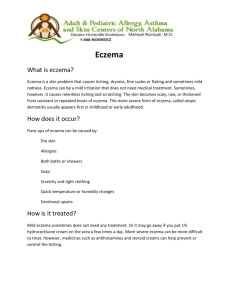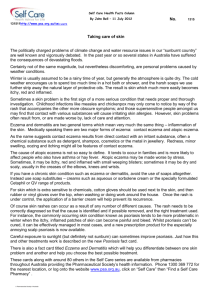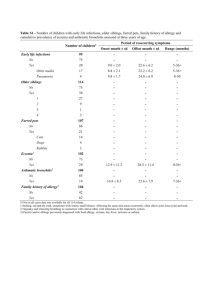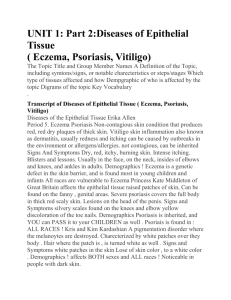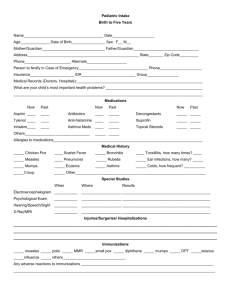Eczema Skin Care Instructions
advertisement
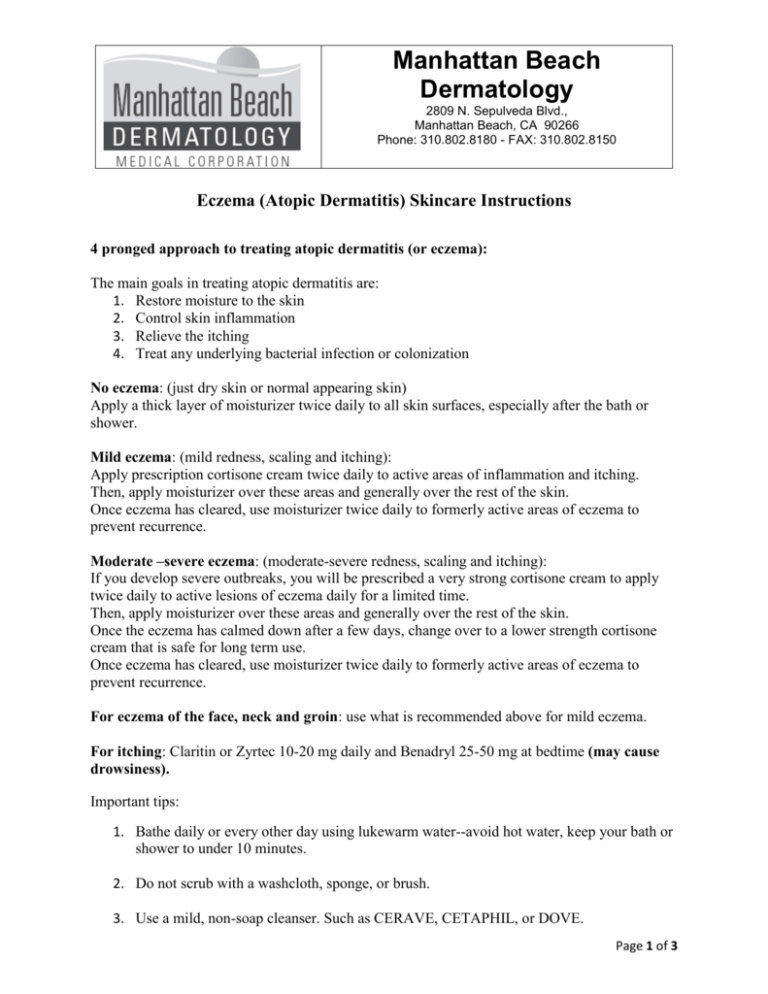
Manhattan Beach Dermatology 2809 N. Sepulveda Blvd., Manhattan Beach, CA 90266 Phone: 310.802.8180 - FAX: 310.802.8150 Eczema (Atopic Dermatitis) Skincare Instructions 4 pronged approach to treating atopic dermatitis (or eczema): The main goals in treating atopic dermatitis are: 1. Restore moisture to the skin 2. Control skin inflammation 3. Relieve the itching 4. Treat any underlying bacterial infection or colonization No eczema: (just dry skin or normal appearing skin) Apply a thick layer of moisturizer twice daily to all skin surfaces, especially after the bath or shower. Mild eczema: (mild redness, scaling and itching): Apply prescription cortisone cream twice daily to active areas of inflammation and itching. Then, apply moisturizer over these areas and generally over the rest of the skin. Once eczema has cleared, use moisturizer twice daily to formerly active areas of eczema to prevent recurrence. Moderate –severe eczema: (moderate-severe redness, scaling and itching): If you develop severe outbreaks, you will be prescribed a very strong cortisone cream to apply twice daily to active lesions of eczema daily for a limited time. Then, apply moisturizer over these areas and generally over the rest of the skin. Once the eczema has calmed down after a few days, change over to a lower strength cortisone cream that is safe for long term use. Once eczema has cleared, use moisturizer twice daily to formerly active areas of eczema to prevent recurrence. For eczema of the face, neck and groin: use what is recommended above for mild eczema. For itching: Claritin or Zyrtec 10-20 mg daily and Benadryl 25-50 mg at bedtime (may cause drowsiness). Important tips: 1. Bathe daily or every other day using lukewarm water--avoid hot water, keep your bath or shower to under 10 minutes. 2. Do not scrub with a washcloth, sponge, or brush. 3. Use a mild, non-soap cleanser. Such as CERAVE, CETAPHIL, or DOVE. Page 1 of 3 4. After bathing, pat the skin with a towel gently. Then immediately apply moisturizer while still in the warm, humid bathroom air. If using a prescription topical medication, use medication first to specific active areas of eczema. 5. Use moisturizers at least twice during the day to the whole body. Ointments are better than creams, which are better than lotions. Apply thickly so that moisturizer appears white on the skin -- in a few minutes it will absorb and then you can get dressed. 6. Use a small amount of fragrance-free laundry detergent to clean your clothes. You may also double rinse clothes after washing. Avoid fabric softeners and dryer sheets. 7. Avoid triggers or irritants; these may include scented soaps, detergents, perfumes, dust, pollens, animal dander, wool or other “scratchy” clothing. Do not wear tight or rough clothing, especially wool. Cotton is best. 8. Keep the temperature and humidity in the home fairly constant. Use a humidifier or vaporizer in the winter. Remember to keep the humidifier clean or mold may spread though out the humidified area. 9. Keep fingernails clean and short. Try to avoid scratching. Scratching can make the rash worse or cause infection. To calm the itching, apply prescription topical medication, wet dressings (see below), ice packs, and/or take oral antihistamines. 10. BLEACH BATHS: Bacteria on the skin may make eczema worse and lead to infection. This simple formula makes for an anti-bacterial bath that is ever gentler than a swimming pool and usually does not sting even when there is some open skin. Steps: Fill a bathtub with warm (not hot!) water (about 40 gallons). Pour ¼ to ½ cup of common liquid bleach into water. Completely mix the added bleach in the water Soak in the chlorinated water for about 10 minutes. Rinse the skin well with warm, fresh water at the end of each bath. You may use a gentle cleanser as well. Gently pat the skin dry Apply the prescription topical medication and moisturizer as directed while the skin is moist. Repeat the bleach baths 3 to 5 times per week or as prescribed by your doctor. 11. COLD WET COMPRESSES: Wet dressings or compresses help create a skin barrier and prevent scratching. They also help increase the penetration of the topical medications. Wet compresses are a powerful treatment and should be used to calm eczema flares 2-3 times a day for the first several days of a flare until the flare is under control. Steps: Page 2 of 3 Apply the cortisone cream or ointment to the inflamed skin. Apply a thick layer of moisturizer to the rest of the skin. Take the wet dressing material (e.g., facecloth or towel) and dip it in the cold water. Wring out the water until the wet dressing is only slightly dripping. Wrap or drape the affected area with the wet dressing material. Keep the room nice and warm (you may feel cold if large areas are treated) After 30-60 minutes, remove the wet dressing, pat the skin dry with a dry towel, and reapply cortisone cream or ointment. These steps can be repeated up to three times a day. Page 3 of 3
